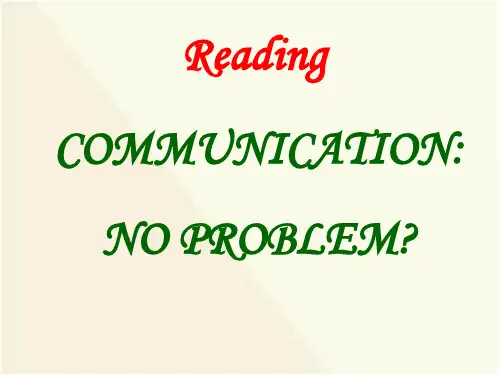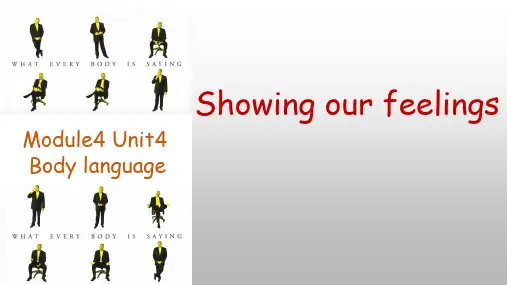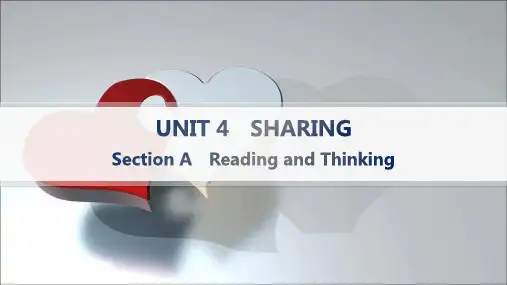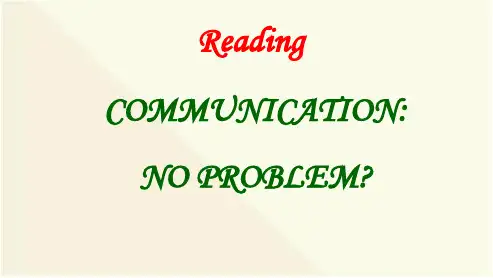人教版高中英语必修四unit4reading课件
合集下载
高中英语必修四4_Unit4_Body_language_Reading新人教版

A conclusion of the passage.
Careful reading
( Read para1-2 Find out the answers to the questions)
1 Who will be present at the meeting?
people from different countries
a Japanese The second mistake
George Cook from (Canada)
He ________ bowed to Mr. Cook and his nose touched Mr. _________ moving Cook’s _______ ________. hand He ________ reached his hand ________ _______ ________ to the out Japanese.
Para.1-2 (example)
people present local businessmen
people representing the Chinese government
2 Why are people visiting China?
purpose mistakes
interest
People from different countries misunderstand each other.
He approaches Ms Smith Mr. Garcia by touching _______ ______ her from The _________ _______ shoulder and kissing (Columbia ) first her on the ________. cheek mistake She ______ stepped ________ back Julia Smith appearing surprised _________ from and take a few steps (Britain) away from _______ ______ Mr. Garcia.
人教版高中英语必修四 Unit4 Body Language reading 课件

Para1 Body language is one of the most powerful means of communication, often even more powerful than spoken language. People around the world show all kinds of feelings, wishes and attitudes that they might never speak aloud. It is possible to "read" others around us, even if they do not intend for us to catch their unspoken communication. Of course, body language can be misread, but many gestures and actions are universal.
but many gestures and actions are universal. Para7 With so many cultural differences between people, it is great
to have some similarities in body language. We can often be wrong about each other, so it is an amazing thing that we understand each other as well as we do!
Para7 With so many cultural differences between people, it is great to have some similarities in body language. We can often be wrong about each other, so it is an amazing thing that we understand each other as well as we do!
新课标人教版高中英语必修四 Unit 4 Body language-communication no problemReading课件

puzzling/confused amazing/surpried
crazy/very sad/unhappy
What do these faces mean?
grievous/sad complaint
happy/shy
What do these faces mean?
amusing/happy laugh at
(para. 5)
students
• Careful reading para1
• Judge the following sentences T or F
• 1. Yesterday, another student and I, representing our university's student association, went to the Capital International Airport to meet this year's international students. T
__g_e_s_tu_r_e_s_, and__p_o_s_t_u_r_e_s_,
or the
ways you stand, are different kinds of body
language.
Let's play game !
• guess
what is he/she doing ?
Some body languages are different in different countries.
1. Is the author of this passage a man or a woman? How do you know?
A man Ahmed Aziz did not shake hands with women, but he shook with the author.
人教版高中英语选择性必修第四册精品课件 Unit 4 SHARING Section A

We left the village the next morning after many goodbyes and firm 9.__h_an_d_s_h_a_k_e_s_ (handshake).My muscles were aching as we dragged 10.__o_u_rs_e_l_v_e_s_ (we) down the mountain towards home.
Activity 2 Read the text again and match each paragraph with its main idea. Para.1 A.The hard trip to Tombe’s village. Para.2 B.The learning conditions in the school. Para.3 C.The bush school for local students. Para.4 D.Feeling nice to get mail. Para.5 E.The dinner in Tombe’s home. Para.6 F.Their belief about leftover food. Para.7 G.The feeling about the trip. Para.8 H.Tombe’s housing.
3.Why did Tombe throw out of the tin can? A.Because he hated the leftover food. B√.Because he believed leftovers attracted evil spirits. C.Because he believed the can had no use at all. D.Because this is a way for people in Papua New Guinea to store leftovers. 4.How did Jo feel after the visit to Tombe’s family? √A.Happy. B.Sad. C.Worried. D.Upset.
Activity 2 Read the text again and match each paragraph with its main idea. Para.1 A.The hard trip to Tombe’s village. Para.2 B.The learning conditions in the school. Para.3 C.The bush school for local students. Para.4 D.Feeling nice to get mail. Para.5 E.The dinner in Tombe’s home. Para.6 F.Their belief about leftover food. Para.7 G.The feeling about the trip. Para.8 H.Tombe’s housing.
3.Why did Tombe throw out of the tin can? A.Because he hated the leftover food. B√.Because he believed leftovers attracted evil spirits. C.Because he believed the can had no use at all. D.Because this is a way for people in Papua New Guinea to store leftovers. 4.How did Jo feel after the visit to Tombe’s family? √A.Happy. B.Sad. C.Worried. D.Upset.
高中英语人教版必修四_Unit4_Body_language_Reading (2)ppt课件

4.
5. 6.
Listening find the characters and where they are from?
Character Mr. Garcia Country
Columbia
Britain
Julia Smith
Mr. Cook A Japanese
Canada
Japan Jordan
F
Country/Area Britain
Ways to greet each Shake hands. Do not stand very close to others or touch strangers as soon as they meet
Canada
Japan
Shake hands.
Make the list of feelings and act it out
Meaning Action 1.
A smile and a handshake
1. You are welcome.
●
2. I am worried 3. I ate too much!
2. Twisting hands together or
To communicate with others To tell and express our thoughts, feelings, reactions etc.
What is body language?
What is body language?
Body Language is a form of non-verbal communication. It uses movements or positions of our body to show other people what we are thinking or feeling. It includes body movements, facial expressions, gestures, posture , speaking distance and other non-verbal signals.
2019年高中英语人教必修四 Unit4 Communication no problem阅读[课件] (共14张PPT)
![2019年高中英语人教必修四 Unit4 Communication no problem阅读[课件] (共14张PPT)](https://uimg.taocdn.com/3c003c1501f69e3143329469.webp)
Who are they and where do they come from?
Tony Garcia Julia Smith Akira Nagata George Cook Ahmed Aziz Darlene Coulon
Columbia Britain Japan Canada Jordan France
American countries
Do not stand _ve_r_y_c_l_o_s_e_to others or touch _s_tr_a_n_g_e_r_s when they meet.
_A_p_p_ro__ac_h__others closely and are more likely to_t_o_u_c_h_t_h_e_m_.
we know how to behave correctly
No problem? and properly in different countries.
Successful communication?
No problem!
If not, you will have difficulties.
Unit 4 Body Language
Communication: No problem?
skimming
1.How many international students are there in the story? Six 2.Who are they and where do they come from?
Scanning Describe the two mistakes
scanning Fill in the table according to Para4:
高中英语人教版必修四unit4_Body_language-reading公开课课件ppt课件
Part 3: (Para 4 )
Part 4: (Para 5)
D) Examples of learned or cultural “body language”.
Matching the people and the different ways of greeting (para2&5)
Tony Garcia (Columbia) Julia Smith (Britain) Akira Nagata (Japan) George Cook (Canada)
Careful reading :
shakes hands and kisses others twice on each cheek Bows
shakes hands approaches others closely and touches their shoulder and kisses them on the cheek does not stand very close to others or touch strangers
Columbia
Britain
Julia Smith
George Cook Akira Nagata
Canada
Japan Jordan
Ahmed Aziz
Darlene Coulon
You
France China
Fast reading:
Which is the main idea of the text?
reading
Come here !
Good ! / Great !
“No,You can not do that"
OK
• She is deaf and dump, so body languagee.
高中英语人教版必修四unit4精品复习ppt课件
要点导航
(1)①部分否定句
如果句中使用了all,both,every或everyone,everybody,everything,
再使用否定词not,无论not出现在何处,该句都应视为部分否定句,译成
②全部否定句
“并不是……”。
表示全部否定时,
三者或三者以上用none;两者用neither。
②当表示前面的句子所说的情况也适合后面的句子时,如果前面是肯定 句,后面的句子常用so引起倒装句,即”。
generally speaking
Ⅱ.经典句型
1 . Not all cultures greet each other the same way , nor are they comfortable in the same way with touching or distance between people.各种文 化背景下人们互致问候的方式不尽相同,身体接触和相互间距离的程度也并 不一样。(回归课本P28)
语法核心突破
It doesn’t seem ugly to me; ___o_n_t_h_e_c_o_n_tr_a_ry_ (恰恰相反), I think it’s
very beautiful.
It’s rude to _______________________ __t_u_r_n_y_ou(r背b对ack着to你yo的ur老师) and refuse to
要点导航
with ease feel/look at ease put/set sb.at one’s ease
轻易地,毫不费力地
感到/看上去心情放松 使某人放松、松弛
6.in general大体上;一般地 Being respectful to people is subjective,based on each culture,but in_general it is probably not a good idea to give a hug to a boss or teaቤተ መጻሕፍቲ ባይዱher.(回 归课本P30)
【课件】Unit4Sharing+Reading+and+Thinking课件人教版选择性必修第四册
2.Analyze the change of Jo’s feelings and what qualities that she has .
3.Explore the reasons, significance and what to do of being a volunteer.
4. Enhance social responsibility and form an optimistic concept of helping people in need .
While - reading
Para 1 a parcel from home
1. How did Jo feel when receiving the parcel from home? She was excited to receive the parcel.
2. Which expression shows her feeling? ... it was so nice to get some sweets and jam from home ... ... I’ve been dying to have some of my favourite sweets, and it’s always nice to get mail!
a __b_u_s_h___ school
____c_l_a_y_____ floors _____g_r_a_s_s___ roofs
_____d_u_s_t_y___ track covered in ____w_e_e_d_s____
The poor learning condition is described through the sense of sight .
3.Explore the reasons, significance and what to do of being a volunteer.
4. Enhance social responsibility and form an optimistic concept of helping people in need .
While - reading
Para 1 a parcel from home
1. How did Jo feel when receiving the parcel from home? She was excited to receive the parcel.
2. Which expression shows her feeling? ... it was so nice to get some sweets and jam from home ... ... I’ve been dying to have some of my favourite sweets, and it’s always nice to get mail!
a __b_u_s_h___ school
____c_l_a_y_____ floors _____g_r_a_s_s___ roofs
_____d_u_s_t_y___ track covered in ____w_e_e_d_s____
The poor learning condition is described through the sense of sight .
Unit4单词课件-2022-2023学年高中英语人教版(2019)选择性必修第四册
新人教选择性必修四
Unit 04 Sharing
Words and Expressions
Important words
1. dusty adj.布满灰尘的 【教单击材此原处编句辑】母版标题样式
It takes me only a few minutes to walk to school down a dusty track covered in wee单d击s.此第我处二只编级辑要母版几文分本样钟式就走到学校,路上尘土飞扬,杂草丛生。
anyw单a击y此第.有处二编级时辑候母版,文我本样真式想知道,化学对这些学生究竟有多大用处,很少有人
会成为化学第三家级,并且他们中的大多数人学完八年级以后就要回到他们的村
庄去了。
第四级 第五级
【实例品读】 We have passed all relevanBt. information on to the police.
mou单nt击a此in处f编ro辑m母版w文he本r样e 式we had fantastic views,and then down a shaded path to the valle第y二b第级e三lo级w. 我和另外一个第老四级师走了两个半小时才到了那儿——先爬到了一座山的山顶 ,从那儿我们欣第赏五到级 了优美的风景,然后又沿着一条阴凉的小路下到下面
第二级
the rain ou第t三. 级
第四级
【实例品读】 第五级 She pulled out the plug and let the water drain away. 她拔起塞子放掉了水。 B.
2023/4/15
14
【热点归纳】 plug单击so此m处e编th辑i母n版g 标o题n样T式V 做电视广告
Unit 04 Sharing
Words and Expressions
Important words
1. dusty adj.布满灰尘的 【教单击材此原处编句辑】母版标题样式
It takes me only a few minutes to walk to school down a dusty track covered in wee单d击s.此第我处二只编级辑要母版几文分本样钟式就走到学校,路上尘土飞扬,杂草丛生。
anyw单a击y此第.有处二编级时辑候母版,文我本样真式想知道,化学对这些学生究竟有多大用处,很少有人
会成为化学第三家级,并且他们中的大多数人学完八年级以后就要回到他们的村
庄去了。
第四级 第五级
【实例品读】 We have passed all relevanBt. information on to the police.
mou单nt击a此in处f编ro辑m母版w文he本r样e 式we had fantastic views,and then down a shaded path to the valle第y二b第级e三lo级w. 我和另外一个第老四级师走了两个半小时才到了那儿——先爬到了一座山的山顶 ,从那儿我们欣第赏五到级 了优美的风景,然后又沿着一条阴凉的小路下到下面
第二级
the rain ou第t三. 级
第四级
【实例品读】 第五级 She pulled out the plug and let the water drain away. 她拔起塞子放掉了水。 B.
2023/4/15
14
【热点归纳】 plug单击so此m处e编th辑i母n版g 标o题n样T式V 做电视广告
- 1、下载文档前请自行甄别文档内容的完整性,平台不提供额外的编辑、内容补充、找答案等附加服务。
- 2、"仅部分预览"的文档,不可在线预览部分如存在完整性等问题,可反馈申请退款(可完整预览的文档不适用该条件!)。
- 3、如文档侵犯您的权益,请联系客服反馈,我们会尽快为您处理(人工客服工作时间:9:00-18:30)。
4. Which of the following is true? A. French people often greet people by
kissing each other on both cheeks. B. All people around the world now greet
people by shaking hands. C. People from Britain and from South
bowing
everyone
Name Description
Body
To Whom
Language
George Cook
Ahmed Aziz
man from Canada
man from Jordan
shaking hands
shaking hands nodding
everyone
to men to women
Task 3:Decide if the following statements are true (T) or false (F).
(1). Englishmen often stand close to others or touch strangers as soon as they meet. (F)
D. There are different kinds of cultures in the world.
3. From the passage we know, most international students greet others by ______. A. shaking hands B. bowing C. kissing D. touching shoulders
parts and match the main idea.
Part 1.
A.Examples of cultural
(para. 1)
“___b_o_d_y__la_n_g_u_a_g__e______ ”.
Part 2 (para. 2 &3 )
Part 3. (para. 4 )
Part 4. (para. 5)
Darlene woman Coulon from
France
shake hands and kiss people she
twice on each knows
cheek
Scanning: Read the passage again and finish---
Task 1 Try to divide the whole passage into four
This text mainly talks about that different _co_u_n_t_ri_e_s/_c_u_lt_u_re_s_/ __have different _b_o_b_y____language.
people
So we should pay attention to : Different countries have _d_i_f_fe_r_e_n__t __(不同) cultures,
He _r_e_a_c_h_e_s_ __h_is_____ __h_a_n_d__ __o_u_t____ to the Japanese.
The third group
Ahmed Aziz
He moves very ___cl_o_s_e___to you and _sh__a_k_e_s _y_o_u_r_h_a_n_d_.
B.Different people have different__b_o_d_y_l_a_n_g_u_a_g_e_s__ .
C.Summary of_b__o_d_y_l_a_n_g_u_a_g_e_ .
D.The author was sent (went) to _t_h_e_C__a_p_it_a_l _In_t_e_r_n_a_ti_o_n_a_l_A_i_rport to meet this year’s international students.
人教版高中英语必修四 unit4reading课件
2020/8/25
Revision
Ways of communicating
Spoken speaking language ringing
Written writing language typing
facial expfrom (Columbia )
byt_o_u_c_h_in__g __h_e_r__ _s_h_o_u_ld__er__ and k__is_s_in_g__ her on the _c_h_e_e_k___.
She _st_e_p_s__b_a_ck______
Julia Smith from
Task 2 Discuss and try to sum up the main idea:
This text mainly talks about that different __c_o_u_n_tr_i_e_s_/c_u_l_tu_r_e_s_/_people have different _b_o_b__y__ languages.
throughout the world.
Post-reading
Disuss and answer the following question Is the author of this passage male or
female? How do you know? The author is male. Ahmed Aziz will not shake hands with women, but he shakes hands with the author.
Name
Body
To
Description Language Whom
Tony man from kiss on the everyone Garcia Colombia cheek
Julia woman Smith from Britain no touching everyone
Akira man from Nagata Japan
“You” from (China)
You _m__o_v_e_b__a_ck__ a bit.
Task 2
Read the passage carefully , discuss and choose the correct answers
1. What does the text mainly talk about?
when people greet each other, they will have
different_w__a_y_s__(方式). If people don’t know the
cultural differences well, people may have
difficulties in_c_o__m_m__u__n_ic__a_ti_n_g_(交流) with others
A. Two university students meet the international students in the airport.
B. Men and women use different body languages in foreign countries.
C. Different cultures have different body languages.
(2).Most people around the world now greet each other by shaking hands . (T)
(3).Japanese will bow to others as greeting. ( T) (4). People from Jordan will move very close to
Reading
Fast reading
Read the passage in P26 as quickly as you can, anaswer the questions: How many international students are there in the story? Who are they and where do they come from? How do they greet each other? Complete the chart with information from the passage in P27
you as you introduce yourself to them. (T)
(5). People from Jordan will shake hands with a woman as she introduces herself to them. ( F)
(6). Some body languages in some countries are good while some countries’ body language are bad. (F)
gesture action
What is body language?
Body language is one form of nonverbal c_o_m_m__u_n_ic_a_t_io_n___(交流) without using words. Eye contact or gaze(注视), facial_e_x_p_r_es_s_i_o_n___, gestures, and __p_o_st_u_r_e___ (姿势), or the way you stand, are different kinds of body language.
